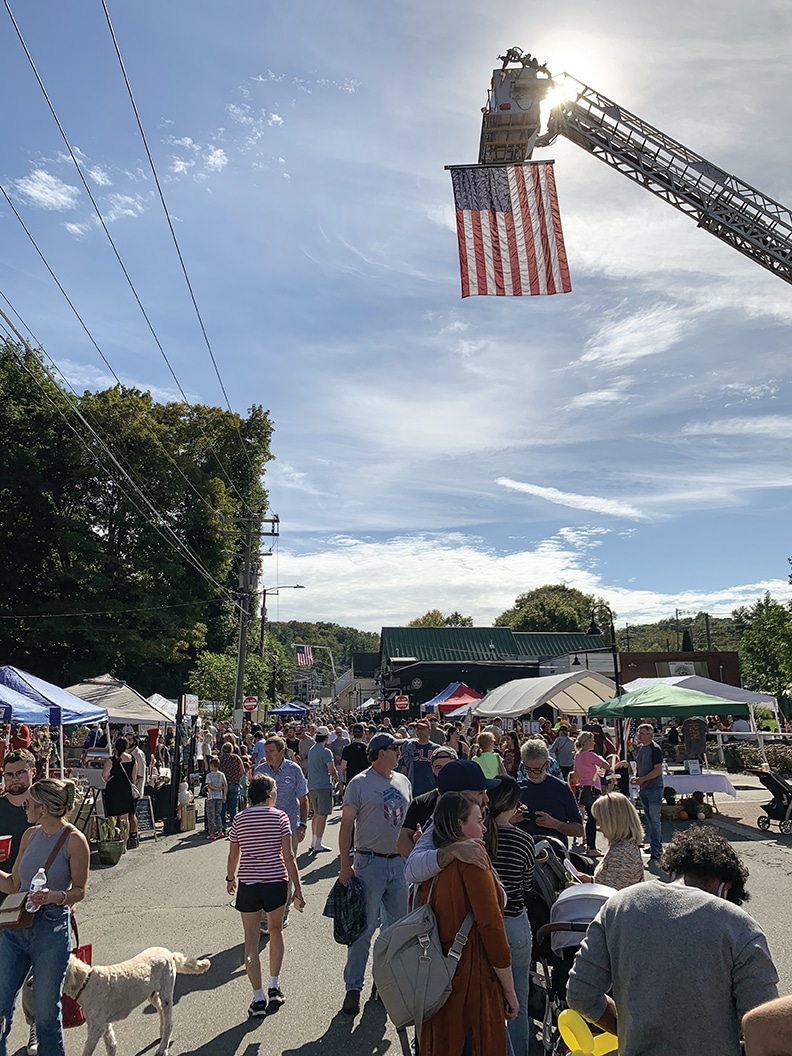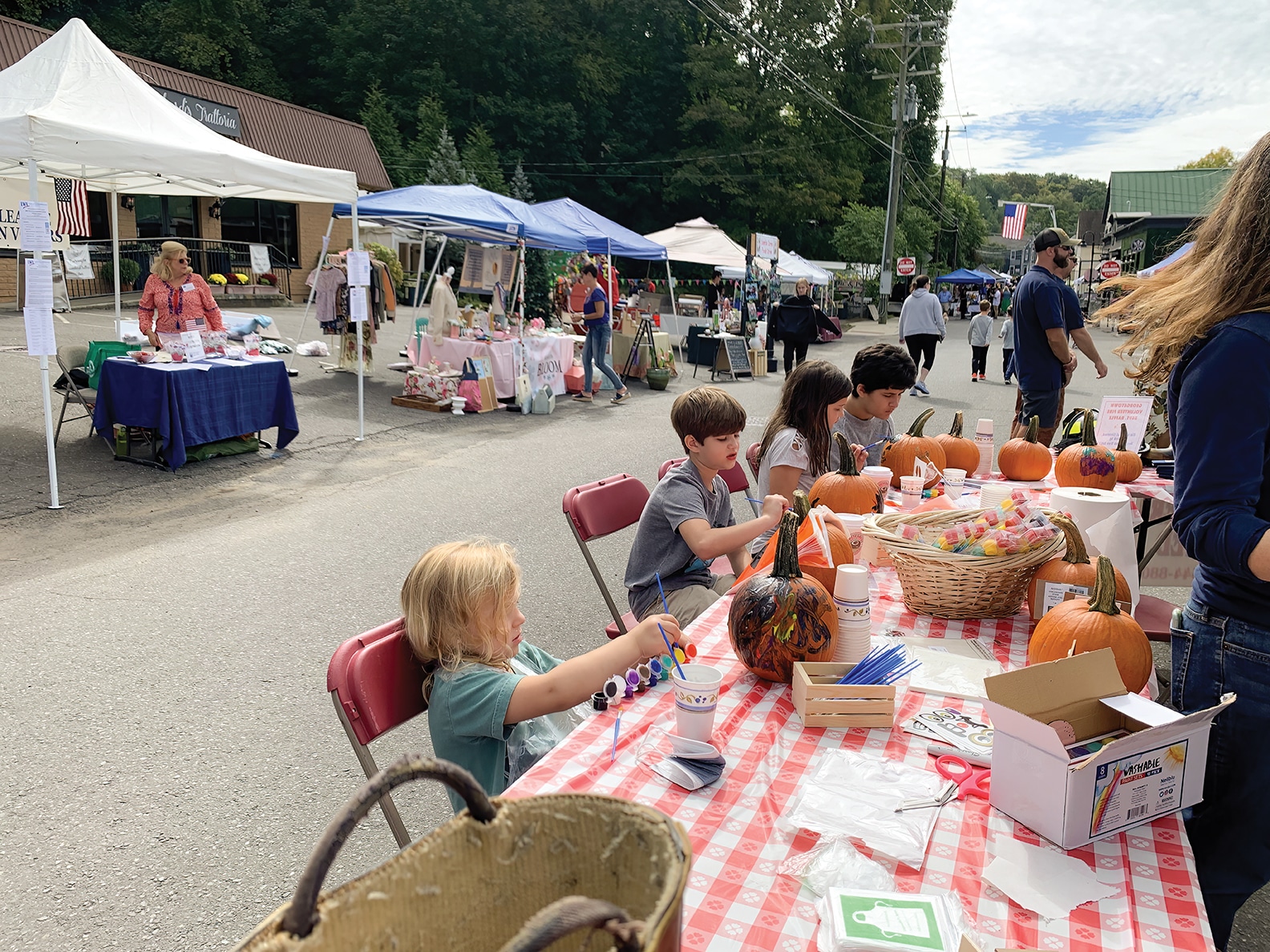The historic village of Georgetown is located where the four corners of Redding, Ridgefield, Weston, and Wilton meet. This hamlet is steeped in history and features restaurants, locally owned shops, and an energetic community of residential homes. With convenient proximity to all of Fairfield County and the train lines into New York City, Georgetown is a quiet respite in contrast to the busier surrounding towns.
Settled in the 1720’s, Georgetown is a small and cozy but lively village with restaurants and shops. Visitors can enjoy lunch and dinner at local favorites like Milestone, Wire Mill Barbecue, Rancho Alegre, 3 Keys Restaurant, Lombardi’s Trattoria, and Black Cat Bar & Grill. Redding Beer Co. offers locally brewed beers on tap, while Georgetown Tavern’s bar is a great place for bellying up. For breakfast and baked goods, there’s Uncle Leo’s Not Just Coffee and Donuts, Old Mill Market, and PopUpBagels (recently featured in the New York Times), while Crystals & Cones is a favorite for ice cream and sweets.
The arts have also long been celebrated in Georgetown. Local artist Kristen Terrana-Hollis created a mural facing Route 107 to welcome visitors to Georgetown, which was completed in late spring 2022. The artwork was commissioned by Georgetown Village Restoration, Inc. (GVR), a nonprofit organization dedicated to maintaining and improving the area, and features local icons like the historic stone Georgetown Bible Church, Mark Twain, and more. “I’ve been a resident of the area for eight years and love Georgetown. It is an honor to create a mural that celebrates its unique history and welcomes people to the vibrant community it is today. There is unlimited potential for Georgetown’s future,” said Kristen.
Creative Culture
There are two art studios in the village; artists can take classes at the historic G&B Cultural Center and Georgetown School of the Arts. Green + Grain offers high-end interior design services, as does Heidi Holzer Design, who also created Trowel & Paper artisanal wallpaper in Georgetown. Olive My Skin is also located on Main Street, with olive oil-based candles and skin care.
Live music has always been a significant part of Georgetown, dating back to the days of the often-reminisced-about Georgetown Saloon. These days, Milestone, 3 Keys, Wire Mill Barbecue, Redding Beer Co., and other spots host local singers and bands.
The village and surrounding zones are both served by Georgetown Volunteer Fire Department, a department of all local volunteers who join forces to protect businesses and residences. There’s a seasonal farmers market every Sunday in the parking lot of Old Mill Market featuring local farms and producers. For nature lovers, Gilbert-Bennett Park is a natural area in the middle of Main Street with beautifully maintained native plants and trees.
Main Street is also host to Georgetown Day, an annual festival that typically takes place on the Sunday before Father’s Day each year. This event is free to the community and features live music, craft and family-friendly vendors, many food vendors and a beer tent, kids’ activities, a chili cook-off, and, most of all, a chance for the Georgetown community to gather and celebrate the historic village.
Visitors to Georgetown will also notice an expanse of large brick factory buildings, formerly called the Gilbert & Bennett Manufacturing Company, where much of Georgetown’s historical significance lies. G&B was first started by Benjamin Gilbert, a Georgetown tanner who started working with livestock hair to create sieves and stuffing for mattresses and cushions; he invented the first machine to pick and separate the hair. Sturges Bennett joined the company as a partner in 1828. The hair-weaving process proved time and labor-intensive, and the partners investigated other options, landing on fine wire and using a neighbor’s carpet loom to weave the wire into wire cloth. During the Civil War, G&B revolutionized the wire industry by adding a protective coat that stabilized it enough to create window screens.
The Gilbert & Bennett factory characterizes a common American theme, right in Georgetown. With a span from 1818 to 1989, the wire mill factory had a good run, but as with many factory towns in America, obsolescence took hold and jobs moved overseas. Fortunately, due to proximity to New York City and the bucolic beauty of the area, the historic village of Georgetown has survived as an active hub.

Historic Landmark and Lofty Goal
The factory is still a central building in Georgetown, though currently only part of it is in use, namely for storage by local commercial businesses. After it was shut down in the late 1980s, efforts by developers to revive and develop the factory buildings stalled in the late 2000s, resulting in years of legal actions. The town was able to regain ownership of the mill after a Connecticut Supreme Court ruling in 2021 and has been taking proactive steps to remediate the property and ready it for its next purpose. The first steps are a grant-funded environmental assessment as well as engineering assessments. From there, the town will work to evaluate potential developers and projects; possible mixed uses include shops, condos, lofts, and more.
Ralph Bosch, board president of the Georgetown nonprofit GVR said, “For over a hundred years, Georgetown and the Gilbert & Bennett factory were the economic engine of the town of Redding and the surrounding area. When the mill closed in the eighties, the tenor of Georgetown changed. Currently we are at a crossroads where the revitalization and reuse of the factory site is poised to help reimagine that economic engine in a new way for both Georgetown and Redding.
“The business hub that surrounds the wire mill site is simultaneously flourishing and biding time through an ever-changing series of challenges, including lack of parking and other needs, but the area has evolved into a mixed use of residential, restaurants, entertainment, and retail and office space. With the anticipated redevelopment of the wire mill property, there is much hope and expectation that the village of Georgetown will be further re-energized, which will both support redevelopment along with the needs of those that live and own businesses in the greater Georgetown area and the surrounding towns.”
There is much hope and many plans for the property to be reimagined and reworked as a beautiful, beneficial part of the Georgetown community a second time around. Many areas in similar circumstances have experienced such revitalizations, and Georgetown has the charm and tenacity to see one through here. Until then, the restaurants and businesses bustle and residents and visitors enjoy both the historic and the modern that comprises the remarkable village of Georgetown.
Many thanks to local historian Brent Colley. He and his informative website historyofredding.net provided much of the historical information in this article. •